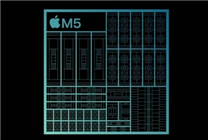Apple Unveils M5 Chip: A Game Changer in Mobile Processing
Summary:
- Apple’s latest M5 chip outperforms Qualcomm’s X2 Elite Extreme and Intel’s Core Ultra 9 285K in single-core performance.
- With a single-core score of 4263, the M5 sets a new benchmark in mobile processors.
- Multi-core performance is expected to improve with upcoming higher-spec variants, such as M5 Pro and M5 Max.
On October 19, Apple announced the launch of its self-developed M5 chip, now featured in the new iPad Pro and 14-inch MacBook Pro. This development marks a significant milestone in the realm of mobile computing.
Benchmarking data from Geekbench reveals that the single-core score of the M5 chip reaches an impressive 4263 points for the MacBook Pro, exceeding the iPad Pro’s score of 4138. This performance is approximately 10% higher than its predecessor, the M4 chip.

Notably, the M5 chip’s single-core performance surpasses Qualcomm’s newly released X2 Elite Extreme, which scores around 4080 points. This positions the M5 as the leader among mobile processors in terms of single-core speed, a critical metric for many applications.
Furthermore, when compared to desktop flagship processors, the M5’s single-core score is only about 4.6% behind Intel’s i9-14900KS, which reaches scores of up to 4457 points. The discrepancy is even smaller when pitted against Intel’s Core Ultra 9 285K, with only a 1% difference in performance.

However, it is essential to note that the M5 chip does face challenges in multi-core performance due to its limited core count of 10. The multi-core running score for the MacBook Pro version of the M5 stands at 17862 points, which is approximately 9% higher than its iPad Pro counterpart. This boost can primarily be attributed to the MacBook Pro’s more robust active cooling system, allowing the chip to operate at a higher frequency (4.61 GHz versus 4.43 GHz) and sustain performance over longer periods.
With the impending release of higher-spec variants, such as the 14-core M5, M5 Pro, and M5 Max, expectations for enhanced multi-core capabilities remain high. This development could potentially close the performance gap with competing AMD and Intel flagship products that boast a higher number of cores.

Overall, the introduction of the M5 chip represents a significant advancement for Apple, solidifying its position in the mobile processing realm. With outstanding single-core performance and the promise of improved multi-core functionality, the M5 is poised to redefine user experiences across a range of applications, from graphic design to complex computations.








